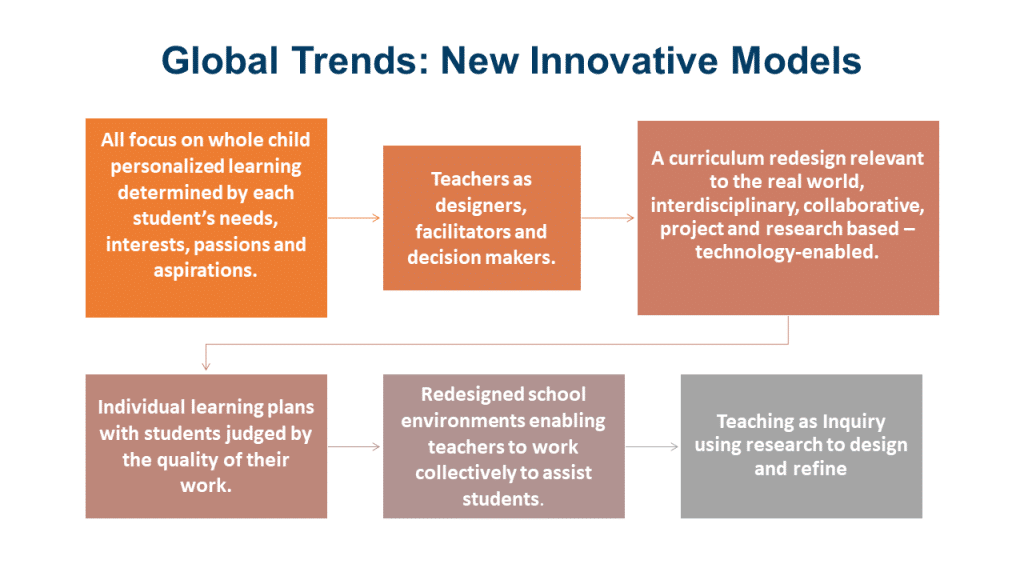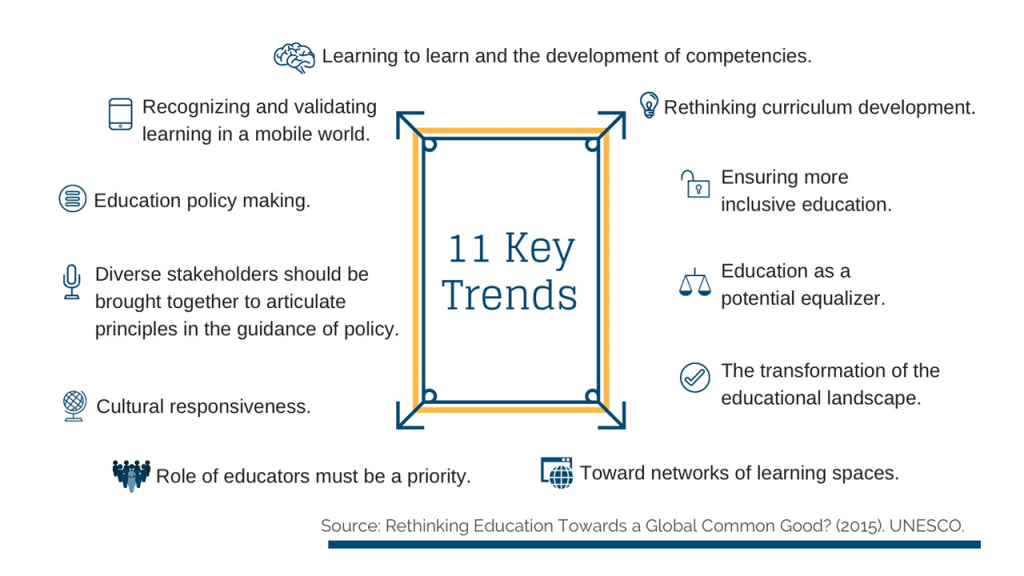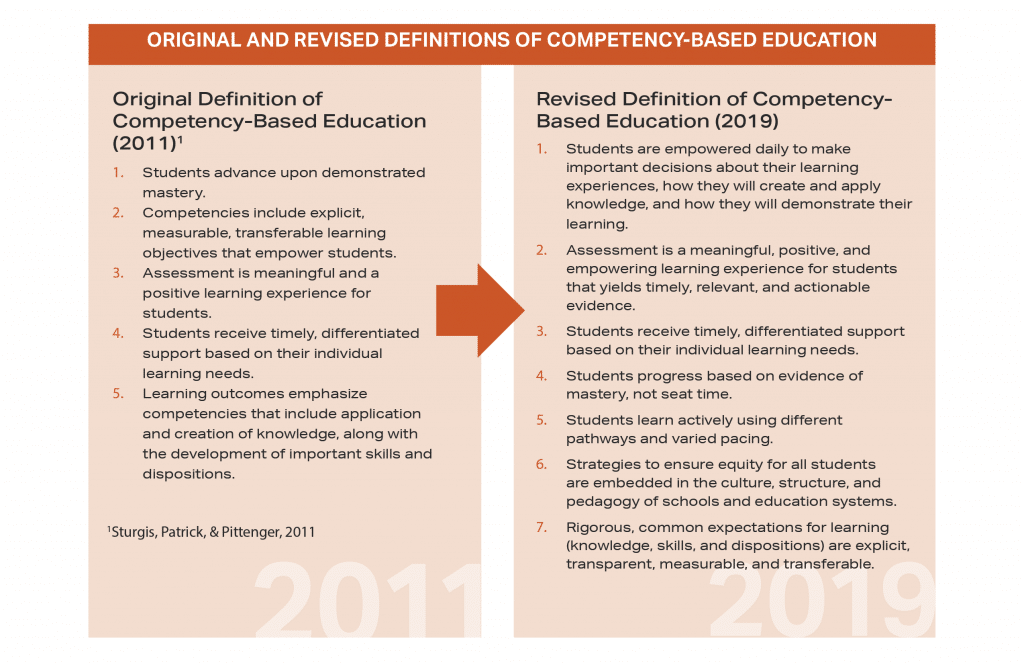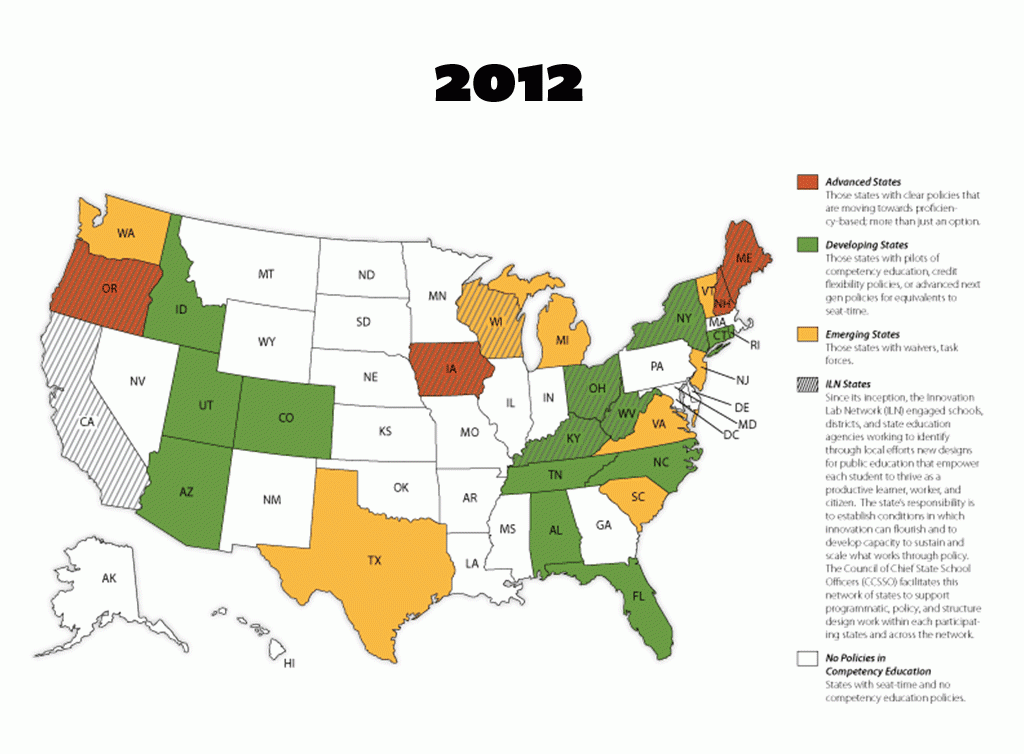The State of the Field, 2019
Education Domain Blog
The following is an excerpted transcript of the State of the Field address, delivered on October 28th at the 2019 Symposium by Aurora Institute President and CEO Susan Patrick. In the address, Susan shares global trends in education, key features of new innovative school models, updates to the definition of competency-based education (CBE), and the growth of CBE policymaking in the United States. Competency-based education fixes fundamental flaws in the traditional model of K-12 schooling, and she offers guideposts for high-quality CBE systems. She closes with a set of 10 focus areas for successful practice.
I’m going to talk about a global perspective and a national perspective on the state of the field. What’s interesting is that as you travel to other countries and talk to ministries of education, global education systems are asking very different fundamental questions. Is our education system fit for purpose for the increasingly complex world we live in today? Is it fit for purpose to create an open and just society that we aim for, for healthy and prosperous futures, for our youth for our communities? To do this, they’re using the research and the learning sciences on how kids learn best. They’re fundamentally examining the purpose of education in today’s rapidly changing context and engaging communities in different conversations about what their hopes are for youth.
We have 18 different countries at this symposium. But it’s amazing. Around the world, many countries have been working on personalized learning for 10-20 years. OECD published this book on personalized learning in the mid-2000s. It’s one of a number of resources that they’ve created on the nature of learning using research to inform innovative models, and this one recognizes the need to move from an industrial one-size-fits-all model.
There was growing awareness that one-size-fits-all approaches to school knowledge and organization are ill-adapted to individuals’ needs and to the knowledge society at large. To move beyond uniform mass production, the factory model, can be described as personalization. It recounts several different countries’ journeys in making this move. In the United Kingdom, David Miliband, who was the minister (of School Standards) said, to pursue “excellence and [equity] simultaneously and aggressively,” we must personalize “to combine flexibility in delivery with accountability for results.” We need more clear data on outcomes for meeting the demand to develop competence of knowledge and skills.
Since 2007, in New Zealand, they went through a full curriculum redesign with a broader definition of success. At the same time, they launched a large initiative for personalized learning. This, along with the alignment of all of their credentials from K-12 through higher education into career tech education and even with the industry training organizations in the workforce, for every licensure, it’s all competency-based and outlines the knowledge and skills of what students need to know and be able to do.
Imagine this.
If in middle school and high school, you have a roadmap to set goals and aspirations that you could begin earning. Level one means basic literacy, basic numeracy. Level two means more advanced, and you earn badges throughout your lifetime. You could go to university and be a lawyer or a doctor and still earn your graphic design credentials and micro-credentials. There are a few states starting to look at this now. Any given state in the United States could begin to do this alignment. In Alabama, they’re calling it a continuous learning system, and they’re just starting to get going. This is toward a very different view of the future.
Global Trends: New Innovative Models
When you look at innovative high school models, innovative school models from all over the world, there are six common trends that you see in the schools.
- All focus on whole-child personalized learning for each student’s needs, interests, passions, and aspirations. They are goal-driven, helping students navigate and be motivated by earning the pathways forward.
- Teachers are designers and decision-makers in these new models.
- A curriculum redesign is at the core about relevance to the real world, interdisciplinary, starting to break apart subjects. [They are] collaborative, project- and research-based.
- There are individual learning plans or personalized learning plans for every student. In New Zealand they call this a student achievement record over a lifetime. We’re starting to see this in Georgia, where they are developing a student learning passport that will build knowledge, skills, and competencies over time into the workforce.
- Redesigned school environments enable teachers to work collectively to support students.
- Teaching as inquiry around using research to design and refine.
The other key global trends [come] from UNESCO. At the top is about learning how to learn and focusing on the development of core competencies. It is rethinking curriculum development and curriculum redesign for more inclusive education and culturally responsive education. The role of educators must be a priority. And we’re seeing networks of learning spaces inside of school and outside of school. This is requiring the recognition and validation of prior learning or learning outside of school walls.
We’re seeing these big changes start to transform the entire educational landscape around the globe. As we stand back, ask what is the problem you’re trying to solve. Often, the most striking, innovative solutions come from realizing maybe that our original concept of the problem was wrong. This is not about tweaking the current education system. This is fundamentally about transforming our education systems toward a higher purpose.
It’s important to get clear on the words that we’re using to describe elements of these new models. What is competency-based education? What does personalized learning really mean? Understanding these definitions impacts the quality of our implementations. And how does this differ from this traditional system that we’re bridging? Personalized learning and competency-based education can mean many things to different people, but it’s really important to think about what those mean, what it is, what policies will support it, and what practices are core to enabling it. Fundamentally, what we’re talking about here is using the learning sciences and research to design and contribute to the future of our education.
In 2011, we brought together more than 100 educators and innovators working in competency-based education to help bring the field around a working definition in five parts. Competency-based education is about students advancing upon demonstrating mastery. It’s about competencies, having clear and explicit learning goals that empower students. They know what their goals are. It’s about assessment being meaningful. They know if they haven’t gotten there yet. They know what they need to do next, and about students immediately getting timely feedback. This means you don’t have gaps as you go from week to week. It’s immediate feedback until you are at proficient or advanced proficiency as you go along, and learning outcomes emphasize the broader range of knowledge and skills.
Now, when we developed this working definition in partnership with the field, we knew that as our knowledge of the field got deeper and deeper that we would need to update it. And we recognize there are two things missing. Two really important concepts missing in this definition: one is student agency and a focus on equity. We believe that equity is the central goal of advancing competency-based education systems. Communities that are aspiring to equity work, to achieve equity, must work toward a system that is built on every child achieving mastery and getting the supports. We revised this revised definition. The first part is [now] on student agency and empowerment, and you will see strategies to ensure equity for all students are embedded in the culture, structure, and pedagogy of schools and education systems. This idea of a competency-based system is designed around learning.
We know that every system is designed to get the outcomes that it achieves. And this is true of our traditional system. It was designed to rank and sort kids to different outcomes. There is high level of variability in our grading. When we have grades from A to F in particular subjects, we know from teacher to teacher from school to school, there’s high variability. Grading systems depend on extrinsic motivation. It’s time-based. Once that time period is over, you go on to the next lesson, to the next day. This leaves huge gaps across a student’s learning pathway. And it’s based on a narrow set of academic options. Literacy and numeracy are absolutely essential, but no longer sufficient. It’s based on a fixed mindset.
A competency-based education system is a full system change. It’s a structure. It’s based on a growth mindset. It’s the culture that believes all students can learn. It’s mastery-based. It builds educator capacity from that calibration. It’s organized for proficiency, and it’s organized to personalized learning. So in 2011, we worked with the field to build a common definition of personalized learning, and there are lots of good frameworks out there, like the LEAP Innovations framework for personalized learning. It’s very detailed, it’s excellent.
Personalized learning is about tailoring learning for students’ strengths, needs and challenges, enabling student voice and choice in what, how, when, and where are they learn to provide flexibility and supports to ensure mastery—there’s the connection with the competency-based system—of the highest standards for all students. It’s holding all students to those high standards but giving flexible approaches. There’s a lot of confusion in the field that flexible pacing equals personalization. And that’s not true. It may be one element of a personalized learning approach, but it does not equal personalization.
Personalization and competency-based education systems go hand in hand. When you think about ensuring all students get to mastery, you can have personalized approaches that result in variable outcomes if it’s not built on a system of mastery. And without personalizing, it’s unlikely that just focusing on competency will reach the outcomes that we hope for.
So what does this look like?
- Every student has a personalized learning plan, a map over time, of the knowledge, skills, and dispositions.
- Data systems are supporting students and teachers clearly indicating where they are, what their level of progress is. Data is far more transparent about what students know and can do and where they need help.
- There are rubrics that help teachers understand what mastery looks like with evidence. Students know their targets, they collaborate with each other.
- Educator roles start to shift, they’re much more collaborative.
- Learning is taking place in the classroom, place-based in the community. More and more we’re seeing in paid internships, so that students are getting relevant meaningful experiences in jobs of interest and bringing back those skills into the classroom. It’s about expanding learning opportunities.
Competency-based education is fundamental to personalizing learning at scale, and it challenges almost all of our assumptions about the present system.
David Hood, from New Zealand, wrote [The Rhetoric and The Reality: New Zealand Schools and Schooling the 21st Century], and in it he describes the need to move from industrial systems of learning, and he calls it the “Paradigm of One:” one teacher teaching one class, one subject of one age using one curriculum at one pace for one classroom for one hour. Is this what our youth need in the world that they’re entering, the world that we’re living in today?
Where Did We Start and Where Are We Now?
In the United States in 2009, there were about a handful of states that started to move from students earning credit, just on seat time: the number of minutes they sit in a seat is how you fill up a high school diploma to graduate. How much does that really tell you about what a student can know and do or what their assets are for their future? One of the core things that we need to begin thinking about as we think about profile of a graduate, broader definitions of success, is are we working with our students on meaningful credentials? And what would a meaningful credential look like?
From 2012 to 2019, we have all states creating flexibility for competency-based systems. This is really exciting. We’re seeing state policy move. We’re seeing more and more states opening up room for these innovations. They’re doing it by states creating innovation zones that offer waivers for districts as they engage in the work and they’ve run into old, outdated rules, outdated laws and addressing them. We’re seeing states put together task forces asking really important questions. But what we need to do to move forward to modernize education to create a future-focused system. We’re seeing credit flexibility, pilot programs for personalized learning and competency-based education.
It’s really exciting to see what is starting to take hold across the states, and multiple pathways to graduation. What are future directions and practice across the field? There are 10 really critical areas that we’re focusing on right now for successful practice. First, and primarily, it’s about innovation for equity. We published Designing for Equity: Leveraging Competency-Based Education to Ensure All Students Succeed, written by Chris Sturgis and Katherine Casey, and it offers equity principles and equity strategies for designing new models. We’ve got to nurture a strong culture of learning and inclusivity. It is very important to engage our communities and continue to engage our communities in the new definitions of success and graduate outcomes. But what if you look over a personalized learning plan for every student? You’re going to have far more transparency in how your system is serving our youth. You have better information, better data to monitor and respond to student progress, proficiency, and pace. It’s about supporting students to build agency and ensuring consistency in our expectations and how we determine proficiency. So you must have equity strategies in place as you’re building new models.
Student agency is the next big area of focus for practice. It’s about creating students with self-efficacy. It’s important to have an explicit theory of change when you get started. How are you going to build that bridge from traditional models toward the future? And core to this is how many communities are engaging in important questions around broader definitions of student success, more holistic definitions of student success for what a graduate needs to know and be able to do. It’s happening at the local level. That’s putting pressure on the state level. This is fundamental to beginning the work, setting that North Star.
It’s about ensuring that we have high-quality learning environments. Chris Sturgis and Katherine Casey authored [Quality Principles for Competency-Based Education] with 16 quality principles offering a quality framework for competency-based systems. We know that on this journey, we might be good at a few things that we’re trying to implement, but there are areas that we’re getting tripped up on. It calls out what success looks like. It calls out “look fors,” or what do you expect to see, and red flags. It offers guidance that we’ve learned from across the field together over the last 10 years.
It’s about building a strong culture, a culture of inclusivity, a culture that is responsive, a culture that is embedded in “all children can learn.” It’s about growth mindset and really understanding what you need to give every student and every educator. Every adult and every student in the system is on a pathway and their own journey. It’s about promoting the broader range of skills and dispositions, including the important social emotional skills.
What’s really interesting to see in some of the models internationally that have been doing this work for 15 or 20 years, is that their schedules look completely different. That is one of the last things that change in the United States with the innovative models, especially in high school. I was just in Westminster, Colorado. And their schedules look very, very different. They’ve got big blocks of time, almost every day, every week. And they’re called WIN time. It’s for “what I need,” so that students can go deeper on what they need. They can get support and help if they’re ahead in one subject and behind in the other. They’ve been doing competency-based education since 2008-09 just like Lindsay, California. When you start to see the structures and the schedules change, that’s when you know you’re really getting advanced in organizing time and resources around kids and what they need.
There is a lot of energy right now on modernizing professional learning, and this is great. We just saw a grant from the U.S. Department of Education on rethinking colleges of education awarded across the country. At the symposium, we got so many proposals on innovative models and districts partnering with local colleges of education and intermediaries, like 2 Revolutions to Southern New Hampshire and others that are really rethinking how we support educators to do preparation and support them over a lifetime of professional learning that’s competency-based and personalized. And, there’s a lot of work happening and micro-credentials and badging around this. It’s still early, but there is so much energy in the field.
We’ve released more than 100 publications researching emerging practices in the field, but please let us know what issues you’re working on and where we might help. These are all openly available, and we want to respond and help build the field shining a light on the future.
I will close with a quote from Víctor García Hoz. This is from 1970.
“Personalized Learning: The learner’s journey to developing their freedom of choice.”
Hoz wrote more than 50 books on personalized learning from the 1970s to the 1990s. Hoz also felt the learning environment should be cognizant of the learner’s cognitive, affective, and social emotional development.
We’re all on a journey. This work is complex, and it matters for our youth, for their futures, for our futures, for our society. We’re all on a path and a journey ahead. There’s no one way to get there. And when I look outside here in Palm Springs, these beautiful mountains remind us, to climb them, it’s one step at a time.
Celebrate how much you’ve accomplished in the past year, in the past years, and give yourself some room to open up to new ideas and visions for the future. Open yourselves up for sharing. Fundamentally, this is not about tweaking the existing system. We are fundamentally examining the culture, the structures, and the policies, building a bridge, shining a light on the future of learning. Thank you for allowing me to set the stage today.
—
See more highlights from the 2019 Symposium.





